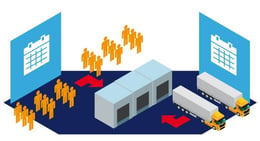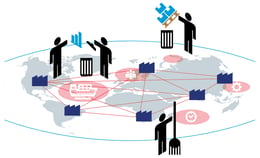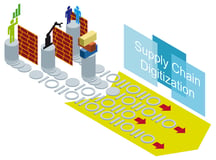5 Steps for Smooth S&OP Implementation
Brian Hoey - February 11, 2020
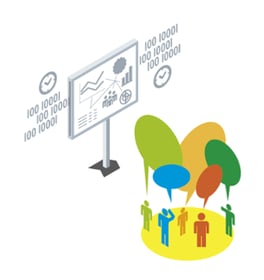
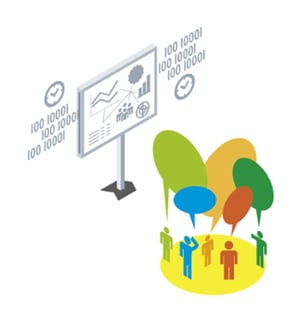 Sales and operations planning (S&OP) is one of the most popular methods that businesses employ for creating a smarter, more responsive supply chains—and with good reason. S&OP can help you identify and take advantage of strategic opportunities that you otherwise might have missed, all through the careful collection and analysis of supply chain data that your value stream is producing anyway. It’s not a panacea—nothing is—but it’s a great start for manufacturers and other businesses who are seeking a leaner and more flexible way to administer supply chain activities.
Sales and operations planning (S&OP) is one of the most popular methods that businesses employ for creating a smarter, more responsive supply chains—and with good reason. S&OP can help you identify and take advantage of strategic opportunities that you otherwise might have missed, all through the careful collection and analysis of supply chain data that your value stream is producing anyway. It’s not a panacea—nothing is—but it’s a great start for manufacturers and other businesses who are seeking a leaner and more flexible way to administer supply chain activities.
All that said, it’s not enough to simply decide that you’d like to have an S&OP workflow and then magically improve your profit margins. On the contrary, you need to choose an appropriate software solution and then implement both the solution and the process itself in a way that’s time-efficient and in line with your larger corporate goals. Considering all the different philosophies out there for the “right” way to do S&OP—not to mention all of the different software options—this is often easier said than done. The question is: how can you implement an S&OP process without succumbing to the many pitfalls and hurdles that can slow down implementation and eat into your ROI?
1. Choose the Right Software
Okay, first things first: S&OP is, by its very nature, a software-driven framework. Why? Because effective S&OP planning depends on digitally tracking supply and demand data in order to create forecasts, analyses, and visualizations. If you choose the right S&OP software, all of this will be a breeze, and your quarterly S&OP meetings will be full of well-informed stakeholders collaborating on a highly visible plan. If you choose something that creates information and planning silos, on the other hand, your planning meetings will be hampered by incomplete or incorrect information, and you’ll be forever fighting to stave off disruptions from inventory outages to over-sourced raw materials. How do you make sure you’re choosing the right software? For starters, ask yourself (and your potential vendors) a few questions:
- How flexible is this solution? Can it be adapted to new methods and/or combined with your existing IT quickly and easily?
- How easy is it for relevant stakeholders to access the information they need at any given time?
- What analytics capabilities does the solution have?
- Can it be implemented easily?
- How well does it meet the needs of different stakeholders within the S&OP process?
With the answers to these questions, you can start to get a sense of how easily a particular solution would mesh with your goals and IT environment, and how effectively it would power mid-range demand-supply planning.
2. Connect the Right Data Sources
Once you’ve picked out a solution, you need to implement it. The exact process here will vary considerably from one software offering to another, but for any solution you choose you’ll need to connect relevant sources of data. This is a crucial part of the process, since streams of up-to-date data are the backbone of S&OP planning operations. As such, it’s critical that you connect the right data sources when you’re setting up the software environment. Right now, what’s the most up-to-date, accurate repository of information about what’s in your warehouse? Whatever it is, that’s what you should be integrating. The same goes for logistics plans, production plans, customer orders, and every other value chain process you can think of. For something like live demand tracking, you may want to integrate with third party sources of data (data from your suppliers’ or customers’ IT, for instance), but the same considerations will apply there as well. By taking this approach, you make sure that you’re never putting a plan together based on outdated or incomplete data.
3. Get Stakeholder Buy-in
Okay, you’ve picked out and set up your S&OP solution. The next step is to actually set up your quarterly S&OP meetings. This is where you’ll have to tackle challenges that are more operational than technological—though technology can certainly help. You’ll have to get buy-in from inventory managers, production planners, C-level executives, and transport planners in order to get these meetings up and running. What does getting buy-in look like? Well, for starters, finding a regular time to actually sit down and meet. Beyond that, you’ll need to sell them on the S&OP software in order to make sure that they’re actually engaging with it, otherwise there will be gaps in your information and your plans will be less likely to succeed. This is why it’s key to account for the needs of disparate departments and stakeholders when you’re selecting your solution in the first place. Once you’re meeting the needs of these different stakeholders, they’ll be more engaged in the process and thus more likely to work towards success.
4. Choose Your KPIs Carefully
This is related to the preceding step, but it bears its own mention: make sure you’re tracking, visualizing, and reporting on the right KPIs. For a larger auto manufacturer, your standard inventory volumes for parts might be so large that tracking them on a daily or weekly basis tells you much less than a quarterly or even year-over-year view. Likewise, a smaller, leaner manufacturing outfit might be more interested in adapting quickly to sudden demand changes, which would mean emphasizing peripheral indicators of demand. Of course, these KPIs don't have to (and, in fact, shouldn’t) remain static over time. Reevaluate every so often whether or not you’re tracking to right metrics for your particular goals.
5. Leverage Advanced Analytics
Different S&OP platforms will have different features and functionality, but whatever you choose should have some degree of analytics integration. This can and should take the form of advanced predictive algorithms that produce smarter forecasts than a human planner could possibly generate by hand, or prescriptive analytics that suggest process improvements based on a digital map of your existing production and transport networks. These analytics flows are a critical component of the S&OP process, and S&OP planning sessions that rely heavily on those analytics are a good way to ensure that you’re maximizing the value of the supply chain data you create on a daily basis. After, that’s what S&OP is all about: aligning data and processes that already exist for improved results across the board.
LATEST POSTS
- Understand Why Production Planning Needs Specialized Solutions
- Understand Circular Economy in The Manufacturing Industry
- How Can Industry 4.0 IT Integration Be Achieved Smoothly?
- The Significance of Order Sequencing in Discrete Manufacturing
- How to improve your Supply Chain Management: The Power of Control Towers

